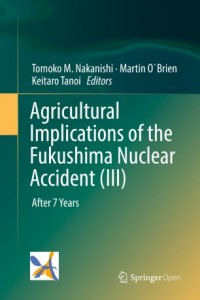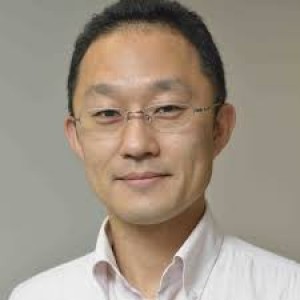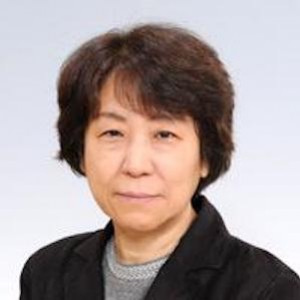
Agricultural Implications of the Fukushima Nuclear Accident (III)
This open access book presents the findings from on-site research into radioactive cesium contamination in various agricultural systems affected by the Fukushima Daiichi Nuclear Power Plant accident in March 2011. This third volume in the series reports on studies undertaken at contaminated sites such as farmland, forests, and marine and freshwater environments, with a particular focus on livestock, wild plants and mushrooms, crops, and marine products in those environments. It also provides additional data collected in the subsequent years to show how the radioactivity levels in agricultural products and their growing environments have changed with time and the route by which radioactive materials entered agricultural products as well as their movement between different components (e.g., soil, water, and trees) within an environmental system (e.g., forests). The book covers various topics, including radioactivity testing of food products; decontamination trials for rice and livestock production; the state of contamination in, trees, mushrooms, and timber; the dynamics of radioactivity distribution in paddy fields and upland forests; damage incurred by the forestry and fishery industries; and the change in consumers’ attitudes. Chapter 19 introduces a real-time radioisotope imaging system, a pioneering technique to visualize the movement of cesium in soil and in plants. This is the only book to provide systematic data on the actual change of radioactivity, and as such is of great value to all researchers who wish to understand the effect of radioactive fallout on agriculture. In addition, it helps the general public to better understand the issues of radio-contamination in the environment. The project is ongoing; the research groups from the Graduate School of Agricultural and Life Sciences of The University of Tokyo continue their work in the field to further evaluate the long-term effects of the Fukushima accident.This open access book presents the findings from on-site research into radioactive cesium contamination in various agricultural systems affected by the Fukushima Daiichi Nuclear Power Plant accident in March 2011. This third volume in the series reports on studies undertaken at contaminated sites such as farmland, forests, and marine and freshwater environments, with a particular focus on livestock, wild plants and mushrooms, crops, and marine products in those environments. It also provides additional data collected in the subsequent years to show how the radioactivity levels in agricultural products and their growing environments have changed with time and the route by which radioactive materials entered agricultural products as well as their movement between different components (e.g., soil, water, and trees) within an environmental system (e.g., forests). The book covers various topics, including radioactivity testing of food products; decontamination trials for rice and livestock production; the state of contamination in, trees, mushrooms, and timber; the dynamics of radioactivity distribution in paddy fields and upland forests; damage incurred by the forestry and fishery industries; and the change in consumers’ attitudes. Chapter 19 introduces a real-time radioisotope imaging system, a pioneering technique to visualize the movement of cesium in soil and in plants. This is the only book to provide systematic data on the actual change of radioactivity, and as such is of great value to all researchers who wish to understand the effect of radioactive fallout on agriculture. In addition, it helps the general public to better understand the issues of radio-contamination in the environment. The project is ongoing; the research groups from the Graduate School of Agricultural and Life Sciences of The University of Tokyo continue their work in the field to further evaluate the long-term effects of the Fukushima accident.
Book Format
Free
Reviews
Rating Snapshot
Select a row below to filter reviews.
0
0
0
0
0
0
Overall
Average Customer Ratings
Review for this Book
Share your thoughts with other readers
More Information
Description of Agricultural Implications of the Fukushima Nuclear Accident (III)
This open access book presents the findings from on-site research into radioactive cesium contamination in various agricultural systems affected by the Fukushima Daiichi Nuclear Power Plant accident i
Additional Information
About the authors
Tomoko M. Nakanishi (Editor)

Graduate School of Agricultural and Life Sciences The University of Tokyo Bunkyo-ku, Tokyo, Japan. Martin O’Brien is a member in the Graduate School of Agricultural and Life Sciences at the University of Tokyo, Japan. His current interest (Jan 2018 - present) is using stable cesium to understand the long-term behaviour of radionuclides in shiitake mushrooms.
Martin O`Brien (Editor)

Graduate School of Agricultural and Life Sciences The University of Tokyo Bunkyo-ku, Tokyo, Japan. I have a Bachelor in Agronomy from The University of Tokyo (UTokyo), Japan. In my Bachelor I carried out research on conservation of water quality and utilization of bottom sediment of lake at Soil Science Laboratory. I was awarded a Master degree in Agronomy from UTokyo. I carried out a project on aluminum toxicity to plant culture cell at Radioisotope Laboratory belong to Department of Applied Biological Chemistry, The University of Tokyo. In the PhD course at the same lab, I started to carry out a research project focusing on radioisotope application in plant nutrition. When I was a PhD student in 2003, I was adopted to Biotechnology Research Center, The University of Tokyo as an assistant professor. I was awarded PhD degree in Agronomy at 2011 with the doctoral thesis entitled, “Magnesium uptake mechanism in rice plant revealed by radiotracer experiments.” I promoted to an associate professor at the current lab at 2012 and a professor at 2018. I have been involved in radioisotope application to plant science and radioisotope imaging techniques since I was a PhD student. After the Fukushima Daiichi Nuclear Power Plant accident at 2011, I started to join projects about radio-contamination in agriculture field and mountain, handling radiocesium measurement. I have been one of administrator of radioisotope facility in the institution, as well as one of the members of radiation management committee in UTokyo.
Keitaro Tanoi (Editor)
Table of content
Recommended Books
Based on the books you like and read






















